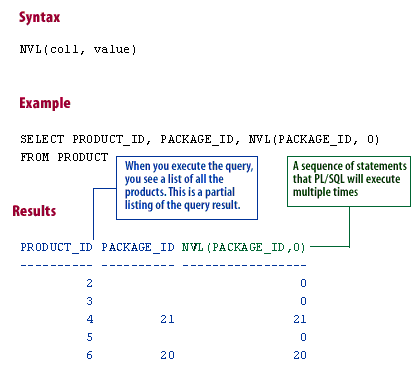Get DataGrip trial now! What is the use of NVL function in SQL? The NVL ( ) function is available in Oracle, and not in MySQL or SQL Server.

This function is used to replace NULL value with another value. NVL lets you replace null (returned as a blank) with a string in the of a query. If expris null , then NVL returns expr2. The arguments exprand exprcan have any datatype.
NVL Function Conversion Details. In Oracle, NVL function is used to replace NULL with the specified value, and can be converted to ISNULL function in SQL Server. NVL (exp exp2) If expis null , the NVL function will return exp otherwise it will return exp1. Expand expshould be same or compatible with the data type. Otherwise, it would return the supplier_desc.
These are all single row function i. The NVL () function returned the first name of salesman if there was a salesman assigned to the sales order, otherwise, it returned the literal string Not Assigned. It lets you substitutes a value when a null value is encountered as well as when a non-null value is encountered. It is similar to the IFNULL Function in MySQL and the ISNULL Function in SQL Server. Tip : You can not use distinct clause within NVL function.
If you want to use distinct clause use it before NVL. The NVL (), IFNULL(), and COALESCE() functions can also be used to achieve the same result. In this case we want NULL values to be zero. NVL is a simple function that replaces a null value with the specified value. It is useful when you want to perform arithmetic on columns that might contain null values.

In these cases, a null value will cause the arithmetic to result in a null value. To avoid this, you can substitute zero for null value using the NVL function. Values that are anything other than null remain unchanged.
The aggregate function max will return a single row (with null in it) even if there are no rows in the table. The ISNULL() function lets you return an alternative value when an expression is. The NVL function replace a null expression with other expression. If ais not NULL then ais returned. The equivalent of this function in SQL Server is the ISNULL function.
Those functions are actually similar, but knowing what differentiates them from each other can help you use the correct one for a given situation. Also, using them correctly at work can make you look like a seasoned SQL developer. NULL’ does the trick, but it shows that the behaviour is not entirely the same and would blow some code when doing a tsql -plsql recoding.
I've also tried some equivalent ones recognized in other databases ( NVL (), IFNULL() and COALESCE()), but SQLite doesn't seem to recognize any of them. Oracle NVL , NVLand COALESCE functions. Does anyone have any suggestions or know of a better way to do this. Note that Nz() is limited to queries that are run from within Access itself.
For example, a stored query that uses Nz() will not work if you try to run it from outside Access (e.g., if you try to import the data from the query into Excel). You can use these function for testing equality, comparison operators and check if value is null. Expis NULL it returns Expelse it returns Exp1.
Nincsenek megjegyzések:
Megjegyzés küldése
Megjegyzés: Megjegyzéseket csak a blog tagjai írhatnak a blogba.